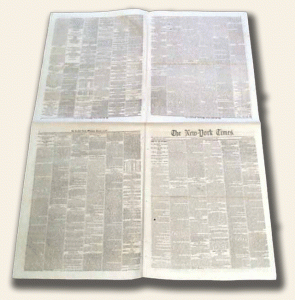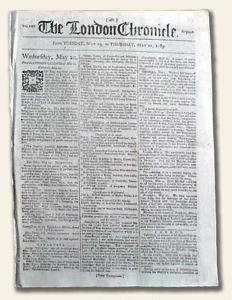Uncut newspapers: leave as they are?
March 20, 2010 by TimHughes · 1 Comment
 Fellow collector Morris Brill poses an interesting question worth sharing with others, along with my thoughts on the issue.
Fellow collector Morris Brill poses an interesting question worth sharing with others, along with my thoughts on the issue.
I suspect we have all encountered “uncut” newspapers from the 19th century, issues which are eight pages in length but which are essentially one large sheet of paper printed on both sides, then folded twice to produce the eight pages. This is how they came off the printing presses . Morris inquires:
“For the sake of maintaining the monetary value of such a newspaper is it best to leave the paper in this one piece condition or is it best to cut the paper so it folds normally like a book and the pages can be turned individually?”
Uncut issues are, for the most part, those which have survived the years by not being bound, kept loose by previous owners and eventually finding their way into the hands of collectors. Given that the vast majority of early newspapers in the collector market came from bound volumes once stored by libraries or other institutions then “disbound” into individual issues, uncut newspapers are relatively few in number. Once bound all margins, save for the spine, are guillotined at the bindery to produce an even, book-like edge thus losing the attachment at the top.
Since uncut issues are newspapers in the original state, as they were sold on the streets, my preference would be to keep them as such. Most collectibles tend to be more desirable in their original state: never clean an old coin; never paint an antique wagon; don’t removed the aged patina from an antique desk, etc. Are such newspapers more clumsy to read? Yes, to some degree. But they can be folded back and all 8 pages read with little difficulty. It’s obviously how it was done years ago as I’ve purchased several boxes of uncut 19th century newspapers which were folded many different ways, left as such by the reader.
They only time I might suggest cutting the top of an uncut sheet is the rare occasion when an issue was bound, causing all four leaves to be attached at the spine, yet the tops have not been trimmed. In such situations the newspaper cannot be folded back because of the attachment at the spine. I would take an exacto knife and cut the very top along the fold. Not much else can be done if the interior pages are to be read.
Collectors may have noticed that we charge a small premium for uncut newspapers. A downside to an uncut issue is they tend to be more worn than those bound as they have not been protected through the years by the bindings, but if one can obtain an issue which is both uncut and in great condition–and contains the Gettysburg Address–there’s a great item for any collection!
Bound or unbound: what’s the difference?
February 17, 2009 by TimHughes · 3 Comments
Many of our listings include a comment “never bound nor trimmed” and you may have wondered what that meant, or what the alternative might be. The alternative is what is mostly found in the market of early newspapers today: issues which have been “disbound” with trimmed margins.
 For hundreds of years it was common practice for institutions, typically libraries and historical societies, to maintain a complete set of newspapers which were within their scope of interest, commonly the locally published newspaper. And to make such storage easy so patrons could easily access issues of a specific year, newspapers were gathered together and bound into what was essentially a large book, typically 3, 6 or possibly 12 months to the volume depending on the number of pages per issue. The New York Times and other dailies of the mid-20th century bound just 15 issues per volume.
For hundreds of years it was common practice for institutions, typically libraries and historical societies, to maintain a complete set of newspapers which were within their scope of interest, commonly the locally published newspaper. And to make such storage easy so patrons could easily access issues of a specific year, newspapers were gathered together and bound into what was essentially a large book, typically 3, 6 or possibly 12 months to the volume depending on the number of pages per issue. The New York Times and other dailies of the mid-20th century bound just 15 issues per volume.
When microfilming became popular in the 1950’s institutions found this alternative a dramatic improvement over the “hard copy”, as microfilm took considerably less space, was much easier to handle, and easier to access the specific date or article needed. As a result, institutions “deaccessioned”, or got rid of the heavy, dusty volumes in favor of microfilm causing huge quantities of newspapers to come on the market. I would guess 98% of the early newspapers available today came from such bound volumes, as they can be carefully disbound, returning the newspapers once again to single-issue status. But with most institutions having already gone through this deaccessioning process, volumes of newspapers are getting increasingly difficult to find.
 In the binding process, much like the book binding process, the edges of the newspapers were trimmed with a guillotine cutter causing all 3 exposed edges to be neat & uniform. If a few of the newspapers were not neatly bound into their proper location some of the text might be lost when the volume was trimmed. You may have a few such issues in your collection.
In the binding process, much like the book binding process, the edges of the newspapers were trimmed with a guillotine cutter causing all 3 exposed edges to be neat & uniform. If a few of the newspapers were not neatly bound into their proper location some of the text might be lost when the volume was trimmed. You may have a few such issues in your collection.
This process explains why so many newspapers 100+ years old might look in near mint condition without a fold & with straight, even edges. They have been protected within the volume and likely sat on a shelf for over 100 years without being touched by human hands. Such issues are nice additions to newspaper collections.
But lucky is the person who is able to find a newspaper purchased off the street so many years ago and put away until being discovered, avoiding the binding and trimming process. The margins will be wider and most 8 page issues fold out to be one huge sheet of newspaper. Typically the downside to such issues is they are more heavily worn not having been protected within a bound volume, exposed to the elements, and typically handled much more frequently through the years.
In my opinion a never-bound, untrimmed issue would be preferable to a bound & trimmed issue as they are definitely more rare and exhibit their natural state as sold on the the date of issue. Finding such an issue in nice, clean condition is the best of both worlds, but condition is usually the trade-off: if you want your issues to be beautiful and clean, you’ll have more luck with disbound issues; if you want your issues to be “as issued” you’ll likely have to accept wear, soiling and ruffled margins.
How do you deal with the disbound or never-bound dilemma for issues going into your collection?


